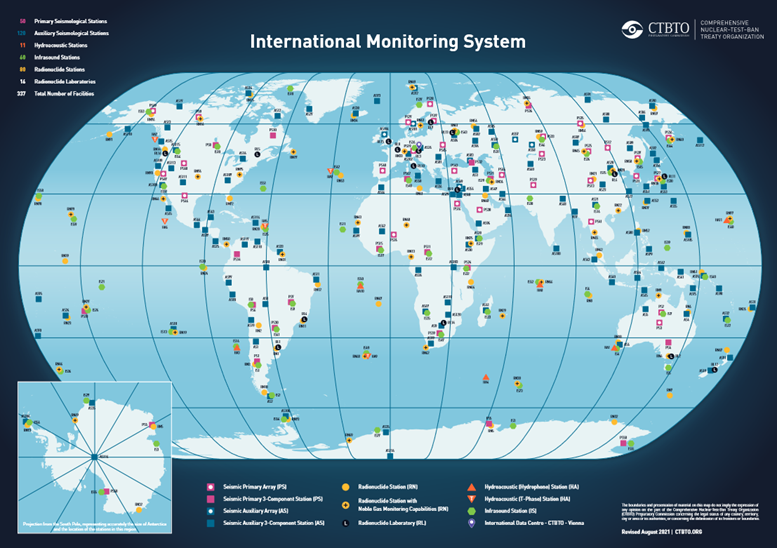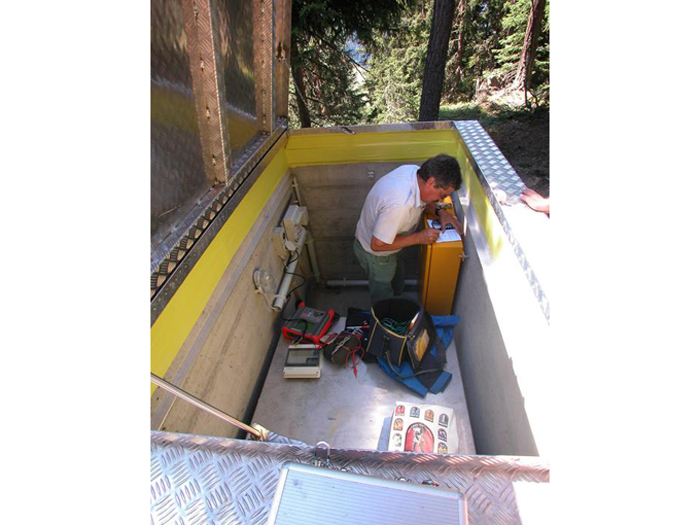In 1996, UN member states agreed a treaty banning all types of nuclear test explosions. The main aim of the Comprehensive Nuclear-Test-Ban Treaty (CTBT) is to prevent future nuclear weapons tests. A global verification regime was set up to monitor compliance with this treaty, including an International Monitoring System (IMS).
The IMS includes seismological, hydroacoustic, infrasound and radionuclide measuring stations and special radionuclide laboratories. It is operated by the Vienna-based Provisional Technical Secretariat (PTS) of the Comprehensive Nuclear-Test-Ban Treaty Organization (CTBTO). The Secretariat works closely with the countries on whose territory the measuring stations are located. Also part of the PTS is the International Data Centre (IDC), where the measurement data from all stations is continuously received and analysed. The data and analyses are available to all countries that have signed the CTBT.

Verification means confirming whether or not something is true. Where major tremors are concerned, verification entails experts telling the authorities and general public whether detected phenomena are of natural origin or were caused by a nuclear explosion. Seismic verification thus involves differentiating between an earthquake and a nuclear explosion (typically an underground nuclear explosion) based on signals measured using a seismometer.
The CTBT prohibits all nuclear test explosions, whether for military or peaceful purposes. It contains a special clause on its entry into force: under Article 14, all 44 states listed in Annex 2 to the treaty (known as Annex 2 states) must have ratified the treaty before it can officially enter into force. These 44 states had nuclear reactors or nuclear test reactors in operation at the time of the treaty negotiations and took part in the treaty negotiations in 1996. Switzerland, also an Annex 2 state, signed the CTBT in September 1996 and ratified it on 1 October 1999.
A key element of the CTBT is the ability to monitor compliance with the treaty in order to detect nuclear tests anywhere in the world. To enable this, the treaty provides for the establishment and operation of a global verification regime consisting of the following components:
- International Monitoring System (IMS)
- International Data Centre (IDC)
- Consultation and clarification process
- Global communications infrastructure
- On-site inspections
- Confidence-building measures
The CTBTO has two subsidiary bodies: Working Group A (WG A) on administrative and budgetary matters and Working Group B (WG B) on verification issues. There is also an Advisory Group on financial, budgetary and associated administrative issues. The Working Groups make proposals and recommendations for consideration and adoption by the Preparatory Commission at its plenary sessions.
More information
- CTBTO
- Status of signature and ratification
- Lecture 'Science Meets Diplomacy and World Security' given at ETH Zurich by Lassina Zerbo, former Executive Secretary of the CTBTO Provisional Technical Secretariat, to mark the 20th anniversary of Switzerland's ratification.
SED role and mandate
From the early 1990s, SED experts were involved in scientific preparations for the CTBT and planning of the monitoring system. After Switzerland signed the treaty in 1996, the SED was designated as the National Data Centre for the CTBT. Since then, the SED, together with the Spiez Laboratory of the Federal Department of Defence, Civil Protection and Sport (DDPS), which is responsible for radionuclide measurements, has also provided the scientific experts for the CTBTO's technical working group.
The SED's various tasks in the context of Switzerland's participation in the CTBT were defined in a 1996 Federal Council decree submitted jointly by the Federal Department of Foreign Affairs (FDFA) and the Federal Department of Home Affairs (FDHA):
- Operating the DAVOX station as part of the International Monitoring System
- Operating the National Data Centre
- Participating in relevant working groups and activities
- Providing information to the authorities and conducting thematic research
The SED also represents Switzerland at meetings of Working Group B at the Vienna International Centre (VIC).
Seismic monitoring network
The International Monitoring System's seismic measuring network consists of 170 stations in 76 countries. Fifty of these stations send their data to the International Data Centre (IDC) around the clock, while the other 120 make their data available upon request from the IDC. The stations are the same seismic stations used for earthquake monitoring or for scientific purposes. They are usually also part of the respective national networks, although they must meet certain quality standards. The SED oversees one of these, the DAVOX station.
This video explains how the CTBTO's seismic monitoring system works:

Earthquake station in Davos
The SED has been operating the DAVOX station near Davos since 2002 as Switzerland's contribution to the International Monitoring System (IMS). On 22 August 2003, the DAVOX station was certified as the ninth of 120 IMS auxiliary seismic stations. DAVOX was integrated into the IDC's operational network on 23 September 2003 and officially inaugurated on 2 October 2003.
Among other things, this station recorded ground shaking 12 minutes after nuclear tests conducted in North Korea, most recently in September 2017 (see SED news article of 3 September 2017).

Certification visit: checking the equipment